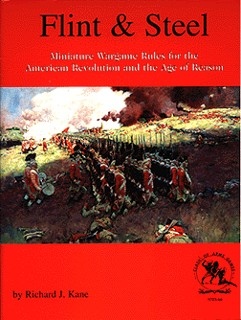
Flint & Steel
Rules focusing on combat operations during the American Revolution, designed to emphasize the differences between infantry units and the effects of leadership. The basic tabletop unit is the battalion/regiment, which are organized into brigades, which in turn form columns (divisions). The rules cover formations, charges, musketry and melee combat,
artillery, and morale.
Target Priority rules limit which units can fire on which targets. After melee, or upon being charges, units may involuntarily retrograde - which in turn may lead to an
enemy advance (sometimes involuntarily). Artillery (guns, howitzers, and mortars) can fire roundshot, grapeshot, caseshot,
or shell, and ammunition is kept track of.
Orders (Attack, Defend, Maneuver, Withdraw, Reserve, Support) are issued to brigades and columns by commanders one turn in advance, but actual orders may differ from the issued orders (especially if the leader is of poor quality). Units are represented by blank stands until "spotted"; dummy stands are also used to simulate the fog of war. The battle concludes when only one player has units remaining on the tabletop.
The Compendium contains ratings for all units and leaders from the Revolutionary War, a random scenario generator, optional rules (reinforcements, infantry ammunition,
fatigue, surprise, night fighting, weather, friendly fire, supplies, communications, flank security, double facing, random events, "large" units, and an alternate basing scheme for 5mm figures), rules and tables covering European Wars, and three scenarios (Bunker's Hill and Cowpens from the Revolutionary War, and Kolin from the Seven Years War).
- Designer
- Richard J. Kane
- Publisher
- Clash of Arms
- Year Published
- 1997
- Status
- Out of Print
- Contents
- 36-page rules booklet
- 64-page Compendium (tables, optional rules, scenarios)
- 6 full-size cards
- 3 reference cards
- 3 marker tracks
- 140 die-cut markers
- Scale
| One figure | 33 infantry or cavalry
4 cannon
or 1 leader |
|---|
| One game turn | 30 minutes |
|---|
| Using 30mm figures | 2 inches | 51mm | 33 yards |
|---|
| Using 25mm figures | 1⅔ inches | 42mm |
|---|
| Using 20mm figures | 1⅓ inches | 34mm |
|---|
| Using 15mm figures | 1 inch | 25.4mm |
|---|
| Using 10mm figures | ⅔ inch | 17mm |
|---|
| Using 5mm figures | ⅓ inch | 8mm |
|---|
- Basing
| Scale | Infantry | Cavalry | Artillery |
|---|
frontage per figure
X depth | frontage
(depth as required) | frontage
(base is square) |
| 30mm | ¾" x 1" | 19mm x 25mm | 1½" | 38mm | 3" | 76mm |
| 25mm | ⅝" x ⅚" | 16mm x 21mm | 1¼" | 32mm | 2½" | 64mm |
| 20mm | ½" x ⅔" | 13mm x 17mm | 1" | 25mm | 2" | 51mm |
| 15mm | ⅜" x ½" | 10mm x 13mm | ¾" | 19mm | 1½" | 38mm |
| 10mm | ¼" x ⅓" | 6mm x 8mm | ½" | 13mm | 1" | 25mm |
| 5mm | ⅛" x ⅙" | 3mm x 4mm | ¼" | 6mm | ½" | 13mm |
| # of figures | usually 3
(sometimes 1 or 2) | 2 | 1 gun plus crew |
|---|
Back to RULES DIRECTORY
Areas of Interest18th Century
Featured Hobby News Article
Featured Ruleset
Featured Showcase Article An unusual addition for your Age of Sail fleets.
Featured Profile Article
|
Miniature Wargame Rules for the American Revolution and the Age of Reason
|




![]() Editor in Chief Bill
Editor in Chief Bill ![]()
![]() looks at a fast-assembly naval kit for the Age of Sail.
looks at a fast-assembly naval kit for the Age of Sail.![]() Editor in Chief Bill
Editor in Chief Bill ![]()
![]() on 13 May 1997. Last revised by
on 13 May 1997. Last revised by ![]() Editor in Chief Bill
Editor in Chief Bill ![]()
![]() on 8 November 2016.
on 8 November 2016.